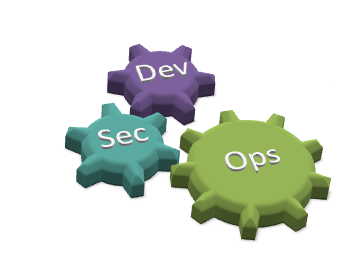The move from DevOps to DevSecOps-Security Tools you need

At this point in time, probably most of us know about the revolution the DevOps movement has created in the area of Software delivery. Many organizations have successfully adopted DevOps practices and continue to shape how they deliver innovative solutions to their customers. DevOps focuses on speed of delivery which is achieved by continuous releases. As teams are pressured to release software more rapidly, there are many challenges to overcome as well - for example, the quality of the software. This has led to a shift-left approach in testing, in which the testing of software has moved up earlier in the software development lifecycle. Another aspect of the software which faces challenges in the DevOps world is the security vulnerabilities of the software.
Traditionally, the role of security was isolated to the security team- a specific team in the final stage of development. This was fine when the development cycles lasted months or years. But those days are no more in the DevOps world. Because of the speed in which code is updated and delivered, security can no longer be thought of as an afterthought in DevOps. There is a need to profess to shift left security and basically embed it as early as possible in the development process. That’s where ‘DevSecOps’ comes in. It is a pretty new term has emerged in the DevOps world, giving new dimensions to the ‘DevOps’ approach. In this blog, let’s take a look at what is DevSecOps all about.
What is DevSecOps?

While DevOps involved collaboration of development and IT operations teams, and made everyone equally responsible for moving the software throughout the delivery pipeline by automating the various tasks across the pipeline ultimately enabling faster releases, DevSecOps takes it a step further by incorporating the security team also in the picture, calling for the adoption of security measures into the development process.
DevSecOps is thus integrating security practices within the DevOps process and aims to build security into app development from end to end. In DevSecOps, everyone in the software development life cycle becomes responsible for security. DevSecOps introduces security in every part of the software development process. It emphasizes the need to help developers code with security in mind, thus embedding security into the development process from the very beginning. With this shifting left approach, the DevSecOps model enables building stuff that is innovative and also secure. Thus, with DevSecOps shifting more of the security responsibility to developers, they might need some security training since security was never been a focus in traditional application development. The ultimate goal of DevSecOps is creating a ‘Security as code’ culture.
In practice, it can be seen that introducing security into the development life cycle is actually not that easy and may act as a hindrance or bottleneck to the entire development process. You can imagine how time-consuming it will be to run manual security checks at different stages in your delivery pipeline. So, how can we tackle this situation and create secure code without compromising the speed and agility that a DevOps model demands? Well, the answer is automation. Automating repeated tasks is the key to DevSecOps. In a DevSecOps environment, automated security testing needs to be performed throughout the development lifecycle.
Security can be integrated into the development lifecycle by running static code analysis on every commit, executing automatic security tests as part of CI/CD process and various other methods. Thus, the code is more secure as it is being written, and the application is continuously validated for common security problems. Thus, possible breach points can be detected earlier in the lifecycle of application deployment minimizing possible vulnerabilities in your software being released. Addressing security risks early in the development lifecycle is much easier and cheaper rather than addressing them later in the cycle.
Tools for DevSecOps
As we have already seen, one of the keys to DevSecOps approach is automation- as early and often as possible, throughout the development life cycle. The traditional security tools for testing and assessing application security risk might not be capable to keep up with the speed that DevOps demands. The automation tools used for DevSecOps model should be capable to create security checks without slowing down the development process and they should not impede the time to market. Remember that the tools you use need to integrate with other tools you use in the DevOps ecosystem, so security becomes an invisible part of the process itself. This way you can make sure your code is secure from the start and enabling you to quickly identify and remediate security flaws early in your process.
Here, we give you a list of tools that can be used to build security testing into your development process and automate it throughout the cycle.
1. CA Veracode : Veracode is one of the most widely used automated security tools which is suitable for DevSecOps environment. It integrates well into the DevOps toolchains available like Eclipse, Jenkins Bugzilla and many more. It has a set of tools that caters to most of the security needs like Static Analysis which studies the code during the build, Greenlight which checks the code for security flaws as you write it in your IDE, Software Composition Analysis which identifies vulnerabilities in the open-source code that was used and Dynamic Analysis security testing which scans and assesses the binaries of third-party providers.
2. Checkmarx: Checkmarx is another tool which helps build security from the start of your SDLC at the speed of DevOps. It is a complete software exposure platform continuously supporting all stages of the DevOps cycle. The platform supports Static application security, Open source analysis, Interactive application security testing, etc. It can be integrated easily with the various CI/CD tools and environments.
3. Continuum security: A very good option to manage threat modeling at the speed of DevOps. They offer two different products for your security needs – IriusRisk and BDD Security.
IriusRisk – It is an integrated console to manage application security risks throughout SDLC – from threat modeling during coding through testing.
BDD Security- Security testing framework for Behavioral Driven Development (BDD) that uses natural language in Gherkin syntax to describe security requirements as features.
4. Evident: Evident from Palo Alto Networks provides continuous security of public cloud infrastructure services enabling you to deploy applications confidently knowing the cloud is configured to meet security requirements. Evident helps you with continuous monitoring of public clouds using the API control plane. It allows the security and DevOps teams to have a clear view of the risks in their cloud environment by analyzing and prioritizing the risks and policy violations. It also performs checks against security best practices, as well as any custom security checks you’ve defined, to identify any potential vulnerability.
5. Aqua Security: It is one of the security platforms that specializes in container security. It comprehensively scans container images and serverless functions for known vulnerabilities, embedded secrets, OSS licensing issues, malware and configuration issues, etc. It integrates easily with CI/CD tools like TeamCity, Azure, Jenkins, Bamboo, Gitlab and many more.
6. Chef Automate’s Inspec : The Inspec project from Chef Automate is a tool which helps you turn your compliance, security and other policy requirements into automated tests. It is a free and open-source framework for testing and auditing your applications and infrastructure. It works by comparing the actual state of your system with the desired state that you specify in an InSpec code to detect violations and displays the findings as a report. The automated tests can be run against traditional servers, containers and cloud APIs alike.
7. Contrast Security: It enables software applications to protect themselves against cyber attacks, heralding the new era of self-protecting software. It uses the deep security instrumentation technology that enables highly accurate assessment and protects an application portfolio without disruptive scanning or security experts. It has two products- Contrast Assess and Contrast Protect. Contrast Assess is the application testing solution which helps you identify vulnerabilities at DevOps speed and delivers security results as fast as the code changes. Contrast Protect is the solution for monitoring and protection for cloud applications.
8. Immunio: Immunio offers a cloud-based Runtime Application Self Protection (RASP) solution that protects your apps against application layer attacks. It provides a much broader security protection for web apps, significantly reduces the risk of exploitation, and is far easier to implement and maintain than traditional solutions such as Web Application Firewalls. Immunio automatically hooks into your web application’s framework at key points where exploit attempts can be detected and automatically prevented, thus protecting your application at run-time.
9. CodeAI: It is a smart automated secure coding application for DevOps which fixes security vulnerabilities in the source code to prevent hacking. It uses a deep learning technology for finding bugs and is capable of continually learning and improving performance in a DevOps environment. It can also fix bugs using simple program transformation schemas derived from bug fixing commits in open source software and additional validation configurations can be made to verify the correctness of fixes. However, the final decision to fix issues still remains in the hands of developers.
10. ThreatModeler: Threat modeler is an automated threat modeling platform that secures and scales the enterprise software development life cycle. It helps you identify, predict and define threats across the entire attack surface. Its DevOps solution provides a seamless, bi-directional communication with your existing DevOps and CI/CD toolchains.
Conclusion
DevSecOps is a relatively new concept that has emerged in the DevOps world and is not yet adopted by many. But security being one of the main concerns of software organizations in the years to come, the move to DevSecOps is in the minds of many organizations. Once implemented correctly and using the right tools, DevSecOps can significantly improve the efficiency, quality and of course the security of the whole software being released. In the months to come, definitely, the adoption of DevSecOps is going to be more widespread making security an integral part of the development workflow, which is a mere advancement of the current DevOps model.
How much is a great User Experience worth to you?
Browsee helps you understand your user's behaviour on your site. It's the next best thing to talking to them.


